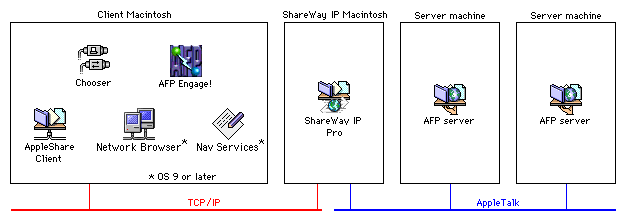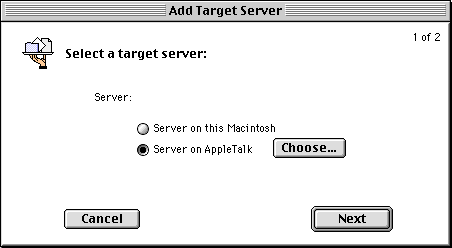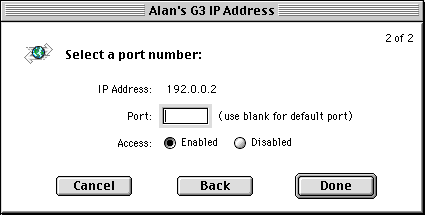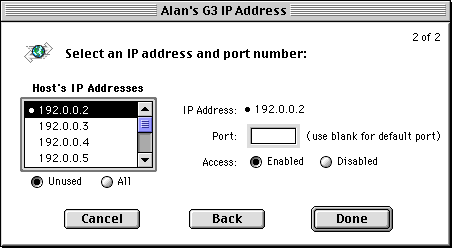
Figure 1. ShareWay IP Professional Installation Configuration
Terminology
ShareWay IP Pro makes AFP servers accessible over IP in two ways. Servers made accessible by each method are referred to differently:
The two methods are described in detail in How ShareWay IP Works.
System Requirements
Preinstallation
If you are not running Mac OS 8.1 or later on the ShareWay IP machine, you can skip this paragraph. If you are running Mac OS 8.1 or later, you may wish to create additional IP addresses for ShareWay IP to use to represent the servers it targets. This procedure is fully documented in the Multiple IP Addresses Appendix, but is briefly outlined below.
Figure 1 below shows the general installation configuration of ShareWay IP Pro. Note that:

Figure 1. ShareWay IP Professional Installation Configuration
In addition to overall configuration, Figure 1 above shows several methods of accessing target servers, including Open Door's AFP Engage!, the Mac OS's Network Browser and Chooser, and applications using Navigation Services. If you wish to take advantage of ShareWay IP's SLP registration functionality (OS 8.5 and later), so that ShareWay can be found dynamically through AFP Engage!, the Network Browser, Navigation Services, or any other SLP browser, be sure the SLP plug-in is in the System's Extensions folder on both the ShareWay and client machines. For details, see Connecting to ShareWay IP.
ShareWay IP Pro can also proxy for servers which already support TCP/IP. Such servers need not be on an AppleTalk network, and can potentially be anywhere on the Internet. SLP proxy is covered in SLP & Proxy in the Basics chapter and in SLP Proxy in the ShareWay IP Windows chapter.
Once you have decided which Macintosh to install ShareWay IP Gateway on, install it by simply dragging it to the hard drive of that Macintosh. If you intend to use ShareWay IP's SLP support, be sure that the SLPPlugin extension is enabled.
To install ShareWay IP's online help (OS 8.5 and later), just keep the file "ShareWay IP Pro Guide" in the same folder as the ShareWay application, and drag the folder "ShareWay IP Pro Help" to the System folder's Help folder on the ShareWay machine. ShareWay IP's help incorporates help for AFP Engage! (separate AFP Engage! online help files are available for installation on client machines, and are covered in the installation section of the AFP Engage! User's Guide).
Note that online help is available through the Macintosh Help Center with OS 8.5 and later, but it is available through ShareWay's Help menu only with OS 8.6 and later.
Quick Start
To use ShareWay IP Professional, you need to:
Before proceeding, you should confirm that:
If you are running Mac OS 9 on the ShareWay machine, you must either:
Begin setup by launching the ShareWay IP application. You will be prompted to enter a serial number. If you do not enter a valid serial number, your copy of ShareWay IP will only run until 10 days from the date you first ran it. To enter a serial number, click "Enter Serial Number...", enter the serial number and click OK. To use ShareWay IP as a temporary eval version, just click OK. See Serial Numbers in the Other Features chapter for details on serial numbers.
After clicking OK, the Gateway Status window appears as shown below in Figure 2.

Figure 2. Gateway Status window
To specify a target server, click the "Target Servers" button, then in the "Target Servers" dialog click "Add...". The "Add Target Server" dialog appears as shown below in Figure 3.

Figure 3. Add Target Server Dialog
Specify whether the desired server is on the same Macintosh as ShareWay IP, or on AppleTalk. If it's on AppleTalk, click the "Choose..." button. A window appears as shown below in Figure 4. If zones appear in the list on the left, select a zone. Then select a server from the list on the right and click "OK", or double-click a server.
Figure 4. Selecting a Server on an AppleTalk Network
If you selected the server on the same Macintosh as ShareWay IP, click the Next button to get to the "IP Address" dialog. If you selected a server on another machine, you will automatically be in the "IP Address" dialog. The dialog appears in one of two forms. If you are running OS 8.1 or later and have implemented multiple IP addresses, the IP Address dialog appears as shown below in Figure 6. Otherwise, it appears as shown in Figure 5.

Figure 5. IP Address Dialog
If the dialog appears as in Figure 5, just enter a port number (enter nothing to use the default of 548), and click Done. If multiple IP addresses are not available, each server supported by ShareWay IP Pro must be assigned a unique port number. If you are running Mac OS 9 on the ShareWay machine and wish to also use the OS's built-in File Sharing over IP, you must use alternate port numbers, secondary IP addresses, or both, for all servers targeted by ShareWay IP Pro. It is recommended that you use port 8548 or higher. Server connections are enabled by default. See Target Server IP Address Dialog in the ShareWay IP Windows chapter.

Figure 6. IP Address Dialog With Multiple IP Addresses Implemented
If the dialog appears as in Figure 6, choose an IP address (and specify an alternate port number if you wish) and click Done. Each server supported by ShareWay IP Pro must be assigned a unique IP address/port number combination. If you are running Mac OS 9 on the ShareWay machine and wish to also use the OS's built-in File Sharing over IP, you must use secondary IP addresses, alternate port numbers, or both, for all servers targeted by ShareWay IP Pro. Server connections are enabled by default. See Target Server IP Address Dialog in the ShareWay IP Windows chapter.
Reselect the Gateway window and click Start to start the gateway. Target servers will not be accessible until the gateway is started.
ShareWay IP Pro can also act as an SLP proxy for servers which already support TCP/IP. Such servers need not be on an AppleTalk network, and can in fact be anywhere on the Internet. SLP proxy is covered in SLP & Proxy in the Basics chapter and in SLP Proxy in the ShareWay IP Windows chapter.
Accessing Targeted Servers
Clients using Mac OS 9 can locate and connect to ShareWay servers through an intuitive point-and-click interface by using:
All clients, regardless of their Mac OS version, can use:
A 50-user license to AFP Engage! 2.0 is included with ShareWay IP 2.0. Details of connecting to ShareWay IP are covered in Connecting to ShareWay IP.